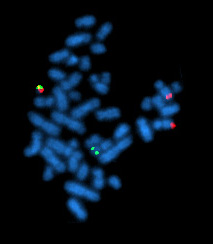Philadelphia chromosome
(Redirected from Bcr-abl fusion protein)
Editor-In-Chief: Prab R Tumpati, MD
Obesity, Sleep & Internal medicine
Founder, WikiMD Wellnesspedia &
W8MD medical weight loss NYC and sleep center NYC
| Philadelphia chromosome | |
|---|---|

| |
| Synonyms | N/A |
| Pronounce | N/A |
| Specialty | N/A |
| Symptoms | Fatigue, weight loss, night sweats, splenomegaly |
| Complications | Chronic myeloid leukemia, acute lymphoblastic leukemia, acute myeloid leukemia |
| Onset | Typically in adulthood |
| Duration | Long-term |
| Types | N/A |
| Causes | Genetic translocation between chromosome 9 and chromosome 22 |
| Risks | Radiation exposure, benzene exposure |
| Diagnosis | Cytogenetic analysis, fluorescence in situ hybridization (FISH), polymerase chain reaction (PCR) |
| Differential diagnosis | Other causes of leukemia |
| Prevention | N/A |
| Treatment | Tyrosine kinase inhibitors, chemotherapy, stem cell transplant |
| Medication | N/A |
| Prognosis | Improved with treatment |
| Frequency | Approximately 1-2 cases per 100,000 people per year |
| Deaths | N/A |
Philadelphia chromosome is a specific genetic abnormality in chromosome 22 of leukemia cancer cells. This abnormality was first discovered in the city of Philadelphia, Pennsylvania and is hence named after it.
Discovery[edit | edit source]
The Philadelphia chromosome was first discovered and described by David Hungerford from Fox Chase Cancer Center and Peter Nowell from the University of Pennsylvania School of Medicine in 1960. It was the first chromosomal abnormality to be associated with a specific disease, chronic myelogenous leukemia (CML).
Formation[edit | edit source]
The Philadelphia chromosome is formed through a process called translocation, where parts of two chromosomes (in this case, chromosome 9 and chromosome 22) swap places. This results in a longer chromosome 9 and a shorter chromosome 22, the latter being the Philadelphia chromosome.
Associated Diseases[edit | edit source]
The Philadelphia chromosome is most commonly associated with chronic myelogenous leukemia. It is also sometimes found in patients with acute lymphoblastic leukemia (ALL) and occasionally in patients with acute myelogenous leukemia (AML).
Treatment[edit | edit source]
The discovery of the Philadelphia chromosome led to the development of the first targeted cancer therapy, Imatinib (Gleevec). This drug specifically inhibits the BCR-ABL1 fusion protein that is produced by the Philadelphia chromosome.
See Also[edit | edit source]
Search WikiMD
Ad.Tired of being Overweight? Try W8MD's NYC physician weight loss.
Semaglutide (Ozempic / Wegovy and Tirzepatide (Mounjaro / Zepbound) available. Call 718 946 5500.
Advertise on WikiMD
|
WikiMD's Wellness Encyclopedia |
| Let Food Be Thy Medicine Medicine Thy Food - Hippocrates |
Translate this page: - East Asian
中文,
日本,
한국어,
South Asian
हिन्दी,
தமிழ்,
తెలుగు,
Urdu,
ಕನ್ನಡ,
Southeast Asian
Indonesian,
Vietnamese,
Thai,
မြန်မာဘာသာ,
বাংলা
European
español,
Deutsch,
français,
Greek,
português do Brasil,
polski,
română,
русский,
Nederlands,
norsk,
svenska,
suomi,
Italian
Middle Eastern & African
عربى,
Turkish,
Persian,
Hebrew,
Afrikaans,
isiZulu,
Kiswahili,
Other
Bulgarian,
Hungarian,
Czech,
Swedish,
മലയാളം,
मराठी,
ਪੰਜਾਬੀ,
ગુજરાતી,
Portuguese,
Ukrainian
Medical Disclaimer: WikiMD is not a substitute for professional medical advice. The information on WikiMD is provided as an information resource only, may be incorrect, outdated or misleading, and is not to be used or relied on for any diagnostic or treatment purposes. Please consult your health care provider before making any healthcare decisions or for guidance about a specific medical condition. WikiMD expressly disclaims responsibility, and shall have no liability, for any damages, loss, injury, or liability whatsoever suffered as a result of your reliance on the information contained in this site. By visiting this site you agree to the foregoing terms and conditions, which may from time to time be changed or supplemented by WikiMD. If you do not agree to the foregoing terms and conditions, you should not enter or use this site. See full disclaimer.
Credits:Most images are courtesy of Wikimedia commons, and templates, categories Wikipedia, licensed under CC BY SA or similar.
Contributors: Prab R. Tumpati, MD



